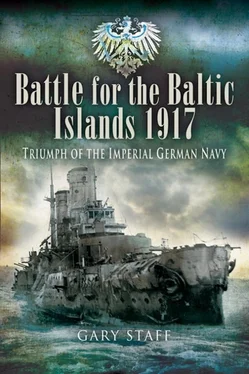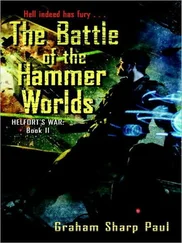The forces to be landed in Tagga Bay were the 131st Infantry Regiment (131 Regt) under Oberstleutnant Fischer, the 255th Reserve Infantry Regiment (255R Regt) under Oberst Berring, and the 65th Infantry Brigade commanded by Oberst Matthiass, which consisted of the 138th Infantry Regiment (138 Regt) and 17th Infantry Regiment (17 Regt). The four regiments were to be landed on the first operational day and spread out to the east and south; their bold objective was to capture the entire Russian garrison. After initially acting in support, 131 Regt was to strike south and capture the Sworbe Peninsula, including the Zerel Battery, and therefore facilitate the forcing of the Irben Straits by the naval forces. The 255R Regt were to strike SE towards Arensburg and capture the town. The 65th Brigade would move to the south and east and try to cut off any Russians retreating towards the east and Moon Island, and prevent any reinforcements coming westward. In consideration of this it was clear that the Island of Moon and its connection to Ösel by a 4 to 5 metre-wide, 3.5 kilometre-long stone dam were of vital importance, particularly to the Russian defenders of Ösel. Reinforcements could come across the dam from Moon and the mainland, and the garrison would also have a secure line of retreat. With this in mind the Russians had constructed bridgeheads at both ends of the stone dam. On Ösel a 6 to 7 km bow stretched from Masik to Saika to Neuenhof. It consisted of field fortifications and barbed wire. The stone dam was also important to the Germans, as to possess it not only prevented reinforcements and precluded the defenders from retreating, it would also isolate them. The earthwork defences were not permanently occupied by the Russians so the German leadership determined on a plan to land some mobile forces, cyclists, on the northern tip of Ösel near Pamerort; they would immediately race across the north of Ösel through Orrisar to the stone dam, in an effort to take the Russians by surprise and occupy the defences first. The Russian line of communication would then be severed. The forces allocated for this task were the I and II Cyclist Battalions and the sturmkompanie (assault company) of Hauptmann von Winterfeld, together with a half battery of guns. The Germans hoped that they would be able to hold the stone dam, or at least delay the Russians.
The German preparations for Operation Albion did not go unnoticed by the Russian forces. The Russian Intelligence Service (SNIS) was still operating with a good deal of efficiency. Vice Admiral Bakhirev wrote:
On September 24th I received news about the arrival in the Baltic of large enemy units in the near future. I let Captain 1st Rank Knüpfer know about this.
On October 3rd the XII Army communicated to me that a night attack and landing on Ösel was expected. I notified the Moon Sound chief in Arensburg about this, and again notified Captain 1st Rank Knüpfer.
On October 10th the Chief of the Operations Department of the Fleet Commander notified me that on the 11th a German fleet operation unknown to us would begin in the Baltic. I communicated the contents of the telegram to Rear Admiral Sveshnikov and ordered Captain 1st Rank Knüpfer to maintain a state of increased readiness.
With the disturbing news about the German fleet I detained some units in the Riga Gulf that were previously detached for leave.
It is clear, therefore, that the Russian fleet commander knew of the commencement date of the German operation. Vice Admiral Bakhirev also passed on this news to the commander of the land forces on Ösel, Kontre Admiral Sveshnikov. Yet when the German sea forces arrived off the Ösel coast it appeared as if their appearance came as a surprise to the defenders.
Before the German operation could be mounted, preparatory minesweeping would have to be undertaken. Nevertheless, a storm which lasted almost two weeks at the end of September had caused a postponement of the operation and only when the westerly blew out in early October could II Minesweeper Flotilla, under Kapitänleutnant Max Doflein, finally begin work in the Irben Straits. This work did not proceed without loss. On 6 October, the minesweeper T54 struck a mine NNW of Lyserort and sank with the loss of seven lives. The following day M31, of the 8th Minesweeper Half Flottille (8 MSHF), struck a mine southwest of Lyserort and sank with the loss of one life. The following day, October 8th, was a particularly bad one, with three minesweepers, M75, T85 and the auxiliary minesweeper Cladow all being damaged, but luckily all were towed safely in. Kapitänleutnant Doflein later wrote:
Sleep only came after coal was replenished and weapons for the coming day were repaired and made serviceable. House high water spouts and explosive clouds, bound with the thunderous crash of the exploding mines, gave news of the progress of the work. Four of my Bootes were blown up in the course of the pioneer work and many brave Offiziers , Deckoffiziers and men perished with them.
Finally, after a delay of around two weeks, the weather improved enough to allow the commencement of the operation. On the evening of 10 October the III and IV Battle Squadrons departed Putzig Wiek and took course northwards. At 0715hrs the following morning they rendezvoused with the unit from Libau and Vizeadmiral Schmidt, General der Infanterie von Kathen and their staffs boarded SMS Moltke . Later in the day the forces from Windau joined the unit so that by early afternoon the invasion fleet was complete and traveling north in four sections at a speed of 9 knots. The first section consisted of light forces: trawlers and torpedoboats of the S-Flotillas fitted for minesweeping and anti-submarine work.
Then came the second section comprised of II Minesweeper Flotilla, II Torpedoboat Flotilla with II Pioneers aboard, three small steamers with III Pioneers aboard, and then the tender Ammon with II Minesweeper Division. The third section was III Battle Squadron with I Pioneers aboard, Moltke , Emden and IV Battle Squadron. Finally came the fourth section, consisting of the transports and fleet train, escorted by II Reconnaissance Group (II AG). The entire force was screened against submarines by the torpedoboat Flotillas, whilst overhead it was covered by seaplanes from the Libau air station. The English submarine E1 was stationed off Libau in an ambush and observation position and observed some of the units from Libau putting to sea, but neither carried out an attack nor realized the significance of what she had observed, and therefore made no report. On 12 October E1 set course back to Hango.
During the afternoon of 11 October the Special Unit progressed slowly northward. Ahead was the first section, preceded by the trawlers of the S-Flotilla of the Baltic with broken out minesweeper gear, then came the second section preceded by the II Minesweeper Flotilla, likewise with sweeper gear set. So far no mines had been encountered. Towards late afternoon the S-Flotilla of the Baltic handed over the minesweeping duties to the other trawlers and Fregattenkapitän Rosenberg hurried ahead to lay out the light vessels along the foreseen route at the nominated points: S, Epsilon, Alpha, Beta, Gamma, Delta and White; some of which were already indicated by U-boats.
Meanwhile, the minesweeping trawlers continued their difficult work. Due to the increasing swell and clinkering of their fires, however, their speed reduced to 5½ knots and then 4 knots. They began to fall behind schedule. At point Gamma there was a ninety degree course alteration to almost due east and in the darkness the 1½ mile-wide sweeper formation fell into complete disarray. A further delay of two hours was incurred before the confusion was unravelled and the trawlers could continue their advance. Fregattenkapitän von Rosenberg realized something was amiss and therefore he made the following wireless signal to the trawlers: ‘Clear the fleet area by 0200hrs’. Nevertheless, towards midnight the II Minesweeper Flotilla caught up with the trawlers and eventually had to bypass them before resuming their minesweeping work. Soon the heavy ships would be approaching from the south.
Читать дальше












